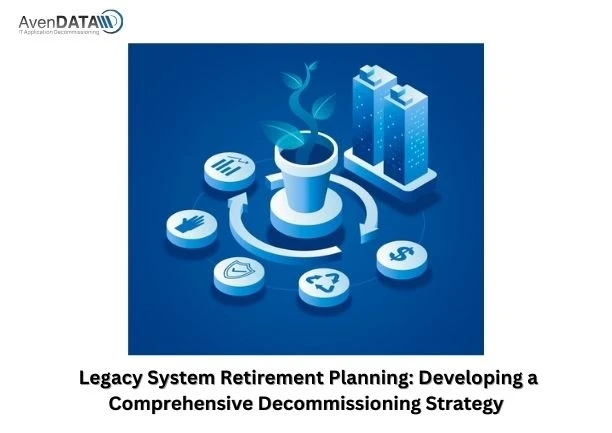In today’s rapidly evolving technological landscape, organizations often find themselves grappling with the challenge of managing legacy systems that no longer meet their evolving business needs. Legacy systems, while once essential for day-to-day operations, can become burdensome and costly to maintain over time. As a result, many organizations are turning to legacy system retirement as a strategic initiative to streamline operations, reduce costs, and drive innovation. However, successful legacy system retirement requires careful planning and execution to minimize risks and maximize benefits. In this blog post, we will explore the key steps involved in developing a comprehensive legacy system retirement strategy.
Assessing the Current State
The first step in legacy system retirement planning is to conduct a thorough assessment of the current state of the organization’s IT landscape. This includes inventorying all existing legacy systems, identifying their functionalities, dependencies, and integration points, and evaluating their performance, usability, and cost-effectiveness. Additionally, organizations should assess the impact of retiring each legacy system on business operations, user workflows, and data dependencies.
Defining Retirement Objectives
Once the current state assessment is complete, organizations should define clear retirement objectives aligned with their strategic goals and business priorities. These objectives may include:
Cost Reduction: Minimizing maintenance and support costs associated with legacy systems.Operational Efficiency: Streamlining business processes and improving productivity by replacing outdated systems with modern solutions.Risk Mitigation: Reducing security vulnerabilities, data integrity risks, and compliance issues associated with legacy systems.Innovation Enablement: Creating opportunities for innovation and digital transformation by retiring legacy systems that hinder agility and scalability.Enhanced User Experience: Improving user satisfaction and engagement by replacing legacy systems with more intuitive and user-friendly solutions.Analyzing Retirement Options
With clear objectives in place, organizations can explore various retirement options based on their specific needs and constraints. These options may include:
System Consolidation: Consolidating multiple legacy systems into a single, integrated platform to streamline operations and reduce complexity.Replacement with Commercial Off-the-Shelf (COTS) Solutions: Identifying and implementing commercial off-the-shelf software solutions that meet the organization’s requirements and offer long-term support and scalability.Custom Development: Building custom software solutions tailored to the organization’s unique needs and requirements, leveraging modern technologies and development frameworks.Cloud Migration: Migrating legacy systems to the cloud to take advantage of scalability, flexibility, and cost savings offered by cloud computing services.Data Archiving and Migration: Archiving historical data from legacy systems and migrating relevant data to new platforms to ensure continuity of business operations and compliance with regulatory requirements.Developing a Retirement Plan
Based on the chosen retirement option, organizations should develop a detailed retirement plan outlining key milestones, timelines, resource requirements, and responsibilities. The retirement plan should include:
Project Scope and Objectives: Clearly define the scope of the retirement project, including the systems to be retired, the expected outcomes, and success criteria.Project Team and Stakeholders: Identify the project team members, stakeholders, and their respective roles and responsibilities.Timeline and Milestones: Establish a realistic timeline with key milestones and deliverables to track progress and ensure timely completion of the retirement project.Budget and Resources: Allocate budgetary resources and secure necessary funding for the retirement project, including personnel, technology, and third-party services.Risk Management: Identify potential risks and mitigation strategies to address challenges and uncertainties that may arise during the retirement process.Communication and Change Management: Develop a communication plan to keep stakeholders informed and engaged throughout the retirement process. Implement change management strategies to minimize disruption and facilitate user adoption of new systems.Execution and Monitoring
Once the retirement plan is in place, organizations can begin executing the retirement strategy according to the established timelines and milestones. It is essential to closely monitor progress, track key performance indicators, and address any issues or obstacles that may arise along the way. Regular communication with stakeholders and project team members is crucial to ensure alignment and transparency throughout the retirement process.
Conclusion
Legacy system retirement is a strategic initiative that requires careful planning, execution, and monitoring to achieve desired outcomes effectively. By assessing the current state, defining clear objectives, analyzing retirement options, developing a comprehensive retirement plan, and executing with precision, organizations can retire legacy systems successfully and pave the way for innovation, efficiency, and growth.
As organizations embark on their legacy system retirement journey, partnering with experienced IT decommissioning experts can provide valuable insights, guidance, and support to navigate the complexities of the retirement process and maximize the benefits of retiring legacy systems. With the right approach and resources in place, organizations can retire legacy systems with confidence and embrace a future of innovation and opportunity.


